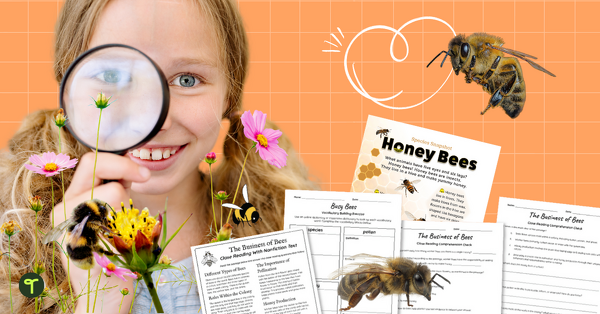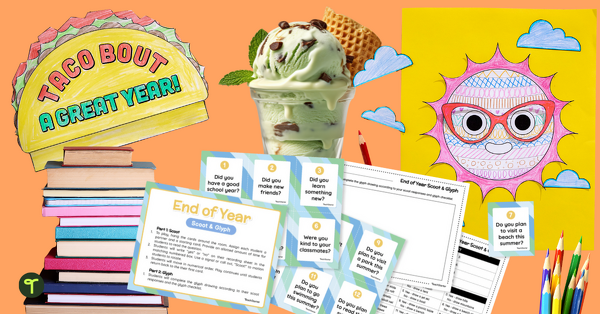Is there anything more nerve-wracking than a teacher observation? Being observed by admin in your classroom as you teach can be one of the most daunting elements of a teacher’s professional development, but it’s also one of the most rewarding!
No matter how confident you are as a teacher or how well-behaved and switched on your students are when your principal settles at that desk in the back of the room, teaching observations can send a cold chill to the heart. And yet … and yet … every member of our teacher team here at Teach Starter has been through dozens of these teaching performance review moments in the classroom, and we have some ideas to help curb the fear. We can’t promise you will find a sudden love for surprise visits from your administrator, but you may just find that confidence you need to really nail the moment!
Explore free worksheets and printable activities for your classroom!
What Is a Teacher Observation?
We realize the name seems pretty obvious, but the regular (or not-so-regular) reviews by your boss can sometimes feel like the world’s biggest trick on teachers rather than what it really is: A chance to grow as a teacher.
The goal is for your administrator or instructional/academic coach to provide constructive feedback on everything from classroom management to instructional technique. Of course, not everyone actually practices the “best practices,” and there are some admins out there who will skip the constructive part and head right into full-blown negative feedback.
But those bad apples shouldn’t spoil your outlook on observation time. Looking at the opportunity to become even better at a career you love is a great way to start things off on the right foot. Now let’s dive into our teacher team’s tips to help you nail this thing, shall we?
Teacher Observation Tips
It’s a fact of life that even the best teachers can have something slip off the radar. We’re all human!
So we will say it again: Use a teaching observation as a chance to regroup, learn, and grow as an educator. Not only does this review of your teaching style provide an opportunity for you to self-check your professional practice, but it is also a great way to show off resources or techniques that make you the fab teacher you are. While most of these tips are focused on a planned observation, there are ideas in here for those surprise pop-ins too.
Prepare Well
Being prepared for your teacher observation is something that, really, goes without saying, but we’re saying it anyway. If you know that you have an observation coming up, don’t let it sneak up on you. Sit down, and write a list of priorities with this at the top and your other tasks listed out below it. That way, you can see what can be set on the back burner for a bit.
Next, ask yourself these questions:
- Do I have all the resources I need?
- Am I aware of any disruptions from outside the classroom that may occur during my observation?
- Have I forewarned my class that there will be another adult in the room and what they’re visiting for?
- Do I have backup resources if my technology doesn’t work?
- Am I 100% sure of the content I’m teaching?
- What will I do if the activity is over more quickly than I anticipate?
As well as preparing your lesson, ensure you have prepared yourself mentally. Try to get a good night’s sleep the night before, and make sure you eat a healthy breakfast! If you’re a meditation or. yoga practitioner, 10 minutes of meditation in the morning is a good idea to get yourself in the zone. If not, at least make sure you have set aside enough time in the morning to get ready so you don’t start the day already on the back foot.
Manage Your Materials
Make sure your lesson materials are printed, organized and ready to go the day before your observation. Nothing is worse than rushing to the copier the morning of only to find it jammed beyond repair. You don’t need that undue stress on your big day.
Before your administrator comes into the room for your assigned time, take care of any prep you or your students need to do to prepare for the lesson. There’s no point wasting 10 minutes of your observation time getting your students to get out the appropriate books, classroom materials, or worksheets.
Make sure student equipment is on hand for immediate hand-out at the appropriate time (or better yet, on student desks already!). If you are using manipulatives or other resources to support your lesson, ensure you have enough for all your students!
If you are using worksheets as part of your lesson, make sure they are appropriate for your students’ learning goals and are clear, meaningful, and without errors. Print an extra copy for your observer.
Teach Starter Teacher Tip: Be sure to write your lesson objective on the board before heading home the night before! Your administrator will be looking for it (along with objectives for other subject areas) upon entering your room.
Planned and Unplanned Differentiation
If you have a classroom of students with diverse needs, then you’re in a normal classroom. So what does differentiation look like for your students?
Ensure you are catering to all levels of understanding during your observed lesson (and every lesson, for that matter!). If you are differentiating by student outcome, have a chat with your observer ahead of time so that they are aware of your thinking and the steps you are taking to cater to your students.
Some ideas for differentiation include:
- leveled activities
- extra-support provided in the form of teacher one-to-one, teacher aide, scaffolding, or extra time
- different methods of presenting (hitting multiple learning styles)
- extra challenges which are on topic for fast-finishers
You may find yourself in the lurch if you have an activity that you thought would suit your students, but it turns out to be far too easy or far too difficult! We know that all too well — it’s one of the many reasons why we create thousands of Teach Starter resources in Google Slides, so you can quickly differentiate every worksheet or activity — and your students won’t be able to see a difference from their peers’ work.
Set Up Your Classroom
No doubt you’ve had your classroom set up for weeks or even months. But as the weeks slip by, bulletin board letters get a little crooked, desks creep to the front, and a general air of “mess” may have settled in. Make sure you’ve tidied up your classroom. Spruce up those visual aids, and fix those bins of manipulatives.
That being said, do not stress out if your assistant principal walks in on a day when your class has coding robots all over the floor and you’ve regrouped your desks for a game of Colonial America Jeopardy. You want your classroom to look like it’s a place for learning, and showcasing your innovative teaching methods is a win.
Make sure your students have their areas tidy as well, but again do not go overboard. Students will be more comfortable working in their natural habitats rather than a display home version of a classroom.
Use Your Time Wisely
Sometimes it can feel like we are racing against the clock in the classroom, and being hurried during your lesson is not how you want to appear! This is where a good lesson plan and planning your brain breaks and transitions will come in handy.
Your lesson observer is there to view your teaching; part of this is how you use your lesson time.
Whether your students are learning a new concept, putting their knowledge into practice, or reviewing a previously taught topic, make sure you use each minute of the lesson as effectively as possible. You don’t want to spend 25 minutes teaching a concept only to have the students run out of time when doing their independent work. Conversely, don’t rush through your modeling to then have a dozen students go back to their desks with confused looks on their faces! Make sure you have enough time for each stage of your lesson.
Are you doing small group work, or will you be working with individual students while other students are busy with center activities? Make sure students understand the classroom procedures for getting your attention when it’s needed – whether you employ hand signals, an “Ask 3 before me” strategy or another method.
Teach Starter Teacher Tip: Do you have to submit lesson plans for review? If not, you may want to print a copy of your lesson plan or have a digital version ready to email to your observer. This weekly lesson plan template can be printed or remain digital!
Work on Your Stage Presence
The classroom’s a stage, and you’re the main star. Can your audience see you? How do you position yourself while you teach?
- Do you stand in an appropriate place while you’re delivering instruction? Can your students in the back of the classroom hear you?
- Do you spend a portion of your lesson time wandering between your students as they work, checking on their progress and understanding?
- Do you only stand or sit in one spot or pace around the room while you’re talking to engage every student?
These are just some of the positioning skills observers may note as they watch you teach. Make sure you’re not walking too quickly. Ensure your students can see you at all times, and more importantly hear you. Varying your vocal tone is much more attention-grabbing than projecting your voice as much as possible.
Engage Your Students
Your actions aren’t the only ones principals are watching during an observation. Student engagement is a big part of what observers look for when they enter the classroom.
- Are all of your learners actively engaged?
- Is everyone paying attention and interested in the material?
- Are there opportunities for all students to speak (such as in a think-pair-share), or are you only calling on those few students with their hands in the air?
- Are you checking for student understanding at various points throughout the lesson?
- How is the rapport between you and each of your students?
A lot of this comes down to your classroom management and behavior management, but it’s also important that you use engaging lesson hook strategies and interactive lesson activities or resources to keep their interest!
Use Participation Strategies
There are a number of things you can do to give your students a nudge if they aren’t participating in the classroom discussion.
You may be tempted to call on your most enthusiastic students during a teacher observation. You know, the ones you can rely on to put their hand up no matter the question.
Try to put your questioning to good use, however, by cold-calling students to ensure a variety of voices. If you are worried that a student will feel stressed or anxious about not knowing the answer, how about asking them their opinion on a topic?
Ask your students to participate in discussion protocols or partner collaboration on your topic. Sometimes, students feel more comfortable speaking to their peers about what they are learning than speaking to the teacher in front of the class. This way, they can voice their thoughts on a topic, and you can wander the room and listen.
Get Students Moving
Minimize disruptions during your observation period by ensuring students have opportunities to move. You can help your students get out their fidgets by encouraging positive movement around the classroom. This could look like a number of different things:
- transitioning between different areas in the room for teacher-led, group, and independent learning
- thumbs up/down/sideways to show their understanding
- engaging in whole-body movements to demonstrate a concept (use your body to attempt to represent a concept or idea!)
- walking around the room to have brief discussions on a topic with their classmates
- incorporating brain breaks at intervals during the lesson
Try to avoid students spending a lot of time out of their seats unless it’s at your direction! If you notice students fidgeting in their seats, it may be time to employ one of the above strategies.
Learn 26 new brain break ideas!
Question Strategically
Strategic questioning is a beautiful thing. You likely already have a strategy when you ask your class questions during your lesson, and it’s important to deploy it during your observation.
One of the most strategic types of questioning you can employ is to stretch your students’ thinking beyond yes and no. You want your students to make connections and engage in higher-order thinking.
Employing critical thinking questioning techniques in the classroom, such as those found within Bloom’s Taxonomy, help push your students’ thinking to the next level!
Check for Understanding
Monitoring your students’ progress during class discussions and independent work is usually second-nature to teachers. Nevertheless, your lesson observer will be checking to make sure no student is left behind.
Monitor your students’ understanding by pausing at appropriate points during the lesson to gauge whether they are ready to move on to the next step.
If necessary, go over the content again to ensure every child is ready. If students are working independently or in groups, actively participate by wandering the classroom and checking on their progress, questioning individual students, and giving feedback to each student so they are aware of their own progress and understanding.
Try adding these formative assessment tools to your arsenal to demonstrate your attention to student assessment (and for your students’ overall benefit!):
Remember What It’s All About
At the end of the day, if you are delivering the best lesson that you can for your kids, then you have nothing to worry about. Everyone makes mistakes, no lesson is ever perfect, and your observer will know that. No one knows your students as well as you, so just do what is best for them, and you’ve done a good job.
Remember, teaching is all about making meaningful learning experiences with your class. Embrace the chance to show off your skills, and learn from the experience. After all, isn’t that what teaching is all about?
Explore our favorite teacher-made teacher tools to help you prep for your observation!
Banner image via Shutterstock/DGLImages







Comments